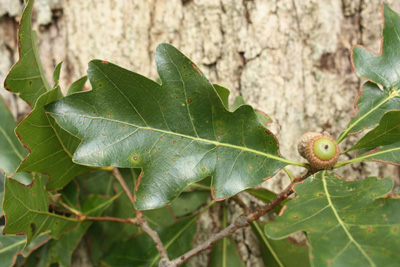Bluff Oak
Quercus austrina
Family: Fagaceae
Natural History

Leaves, acorn, and bark of bluff oak | Photo credit: Niels Proctor, University of Florida
Bluff oak gets its name from the locations where it is most commonly found, on bluffs or slopes above rivers or streams. The tree is most distinctive for its bark, which is a pale yellow-gray and forms vertical strips of plates or scales up the trunk. The bark strips are narrow and less obvious at the base of the tree, but they widen and become more pronounced higher on the trunk.
The leaves of bluff oak have 3 to 7 rounded, shallow lobes along the margin. Individual leaves can be symmetrical along the midvein or they can be very irregular. The acorns are small and are sometimes almost enclosed in the cupule.
Bluff oak is not a widely-known species because it only occurs naturally in a small, narrow strip of the southeastern United States. The native range stretches from Mississippi through the northern part of Florida and up into North Carolina. And even in that area, is is not a common tree. Bluff oak is not widely used commercially and it is not commonly available through plant nusuries, but it is said to have great potential as a landscaping plant. The branches do not need much pruning and they tend to stay upright and out of the way.
